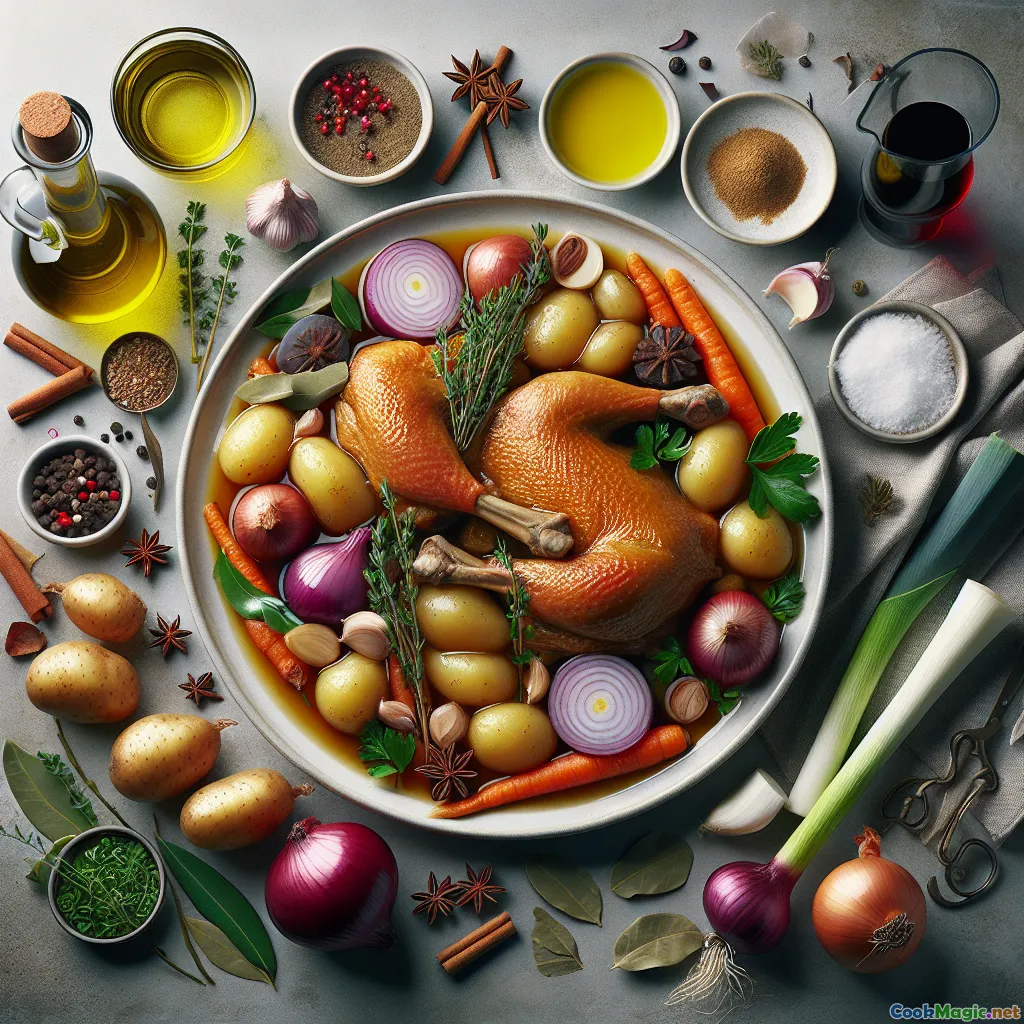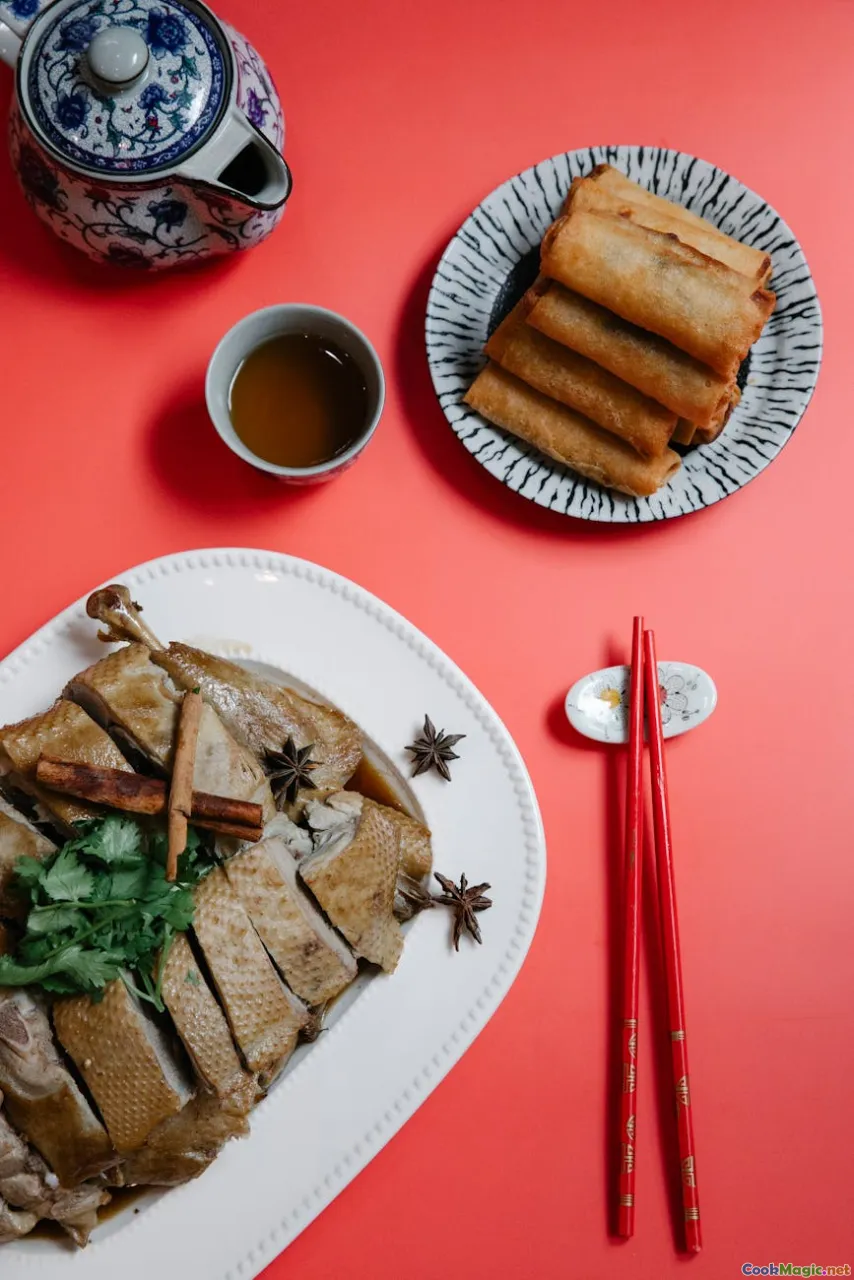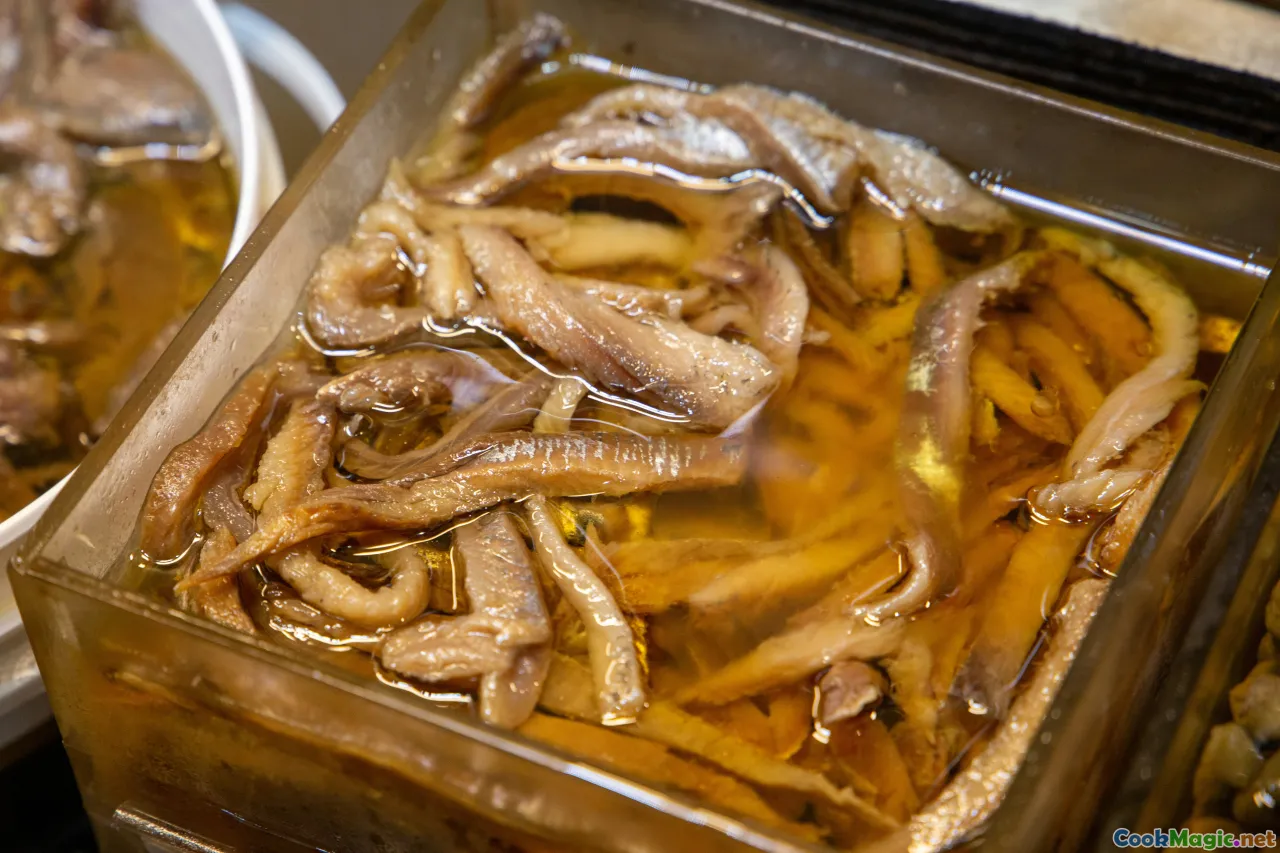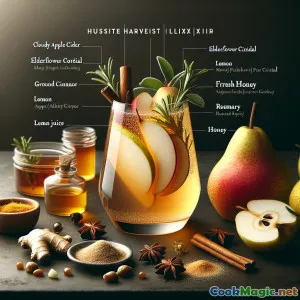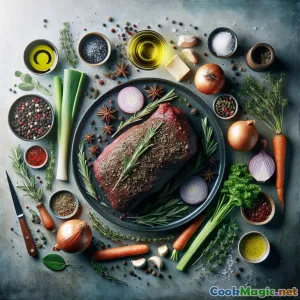
Recette Élégante du Ragoût de Canard à la Cannelle et Clous de Girofle Royal
(Elegant Royal Cinnamon Clove Duck Stew Recipe)
(0 Avis)0
1,404
juillet 22, 2025
Signaler un problème
Ingrédients
-
4 pieces cuisses de canard
(Preferably mallard or wild duck for flavor.)
-
3 tbsp Huile d'olive
(Use extra virgin if possible.)
-
1 piece Gros oignon jaune
(Finement haché.)
-
1 piece Poireau
(Properly cleaned and thinly sliced.)
-
3 pieces Gousses d'ail
(Haché.)
-
2 medium Carottes
(Épluché et tranché.)
-
1 large Panais
(Peeled and cut into rounds.)
-
2 tsp Thym Frais
(Leaves only or 2 whole sprigs.)
-
2 pieces Feuilles de laurier
-
1 tsp Cannelle en poudre
(Freshly ground best.)
-
6 pieces Gousses de clous de girofle entières
(Slightly crushed.)
-
1 cup Vin rouge
(Preferably full-bodied English or French.)
-
3 cups bouillon de poulet
(Low salt.)
-
300 grams Pommes de terre nouvelles
(Cut in half.)
-
1.5 tsp Sel
(Au goût.)
-
1 tsp Poivre noir
(Fraîchement moulu)
-
1 small Navet
(Cubed.)
-
2 tbsp Persil anglais
(Finement haché, pour la garniture.)
(Preferably mallard or wild duck for flavor.)
(Use extra virgin if possible.)
(Finement haché.)
(Properly cleaned and thinly sliced.)
(Haché.)
(Épluché et tranché.)
(Peeled and cut into rounds.)
(Leaves only or 2 whole sprigs.)
(Freshly ground best.)
(Slightly crushed.)
(Preferably full-bodied English or French.)
(Low salt.)
(Cut in half.)
(Au goût.)
(Fraîchement moulu)
(Cubed.)
(Finement haché, pour la garniture.)
Nutrition
- Portions: 4
- Taille de portion: 1 bol (350g)
- Calories: 640 kcal
- Carbohydrates: 0 g
- Protein: 35 g
- Fat: 34 g
- Fiber: 7 g
- Sugar: 6 g
- Sodium: 1050 mg
- Cholesterol: 165 mg
- Calcium: 75 mg
- Iron: 4 mg
Instructions
-
1 - Prepare Duck:
Pat duck legs dry with paper towels. Season all sides with salt and pepper.
-
2 - Brown Duck:
Heat olive oil over medium-high in a heavy stew pot. Add duck legs skin side down and sear until the skin is crispy and browned, about 5 minutes each side. Transfer duck to a plate.
-
3 - Sauté Vegetables:
In the same pot, reduce heat to medium. Add onion, leek, and garlic; sauté until softened, about 5 minutes.
-
4 - Build Flavors:
Stir in carrots, parsnip, cinnamon, cloves, thyme, and bay leaves. Cook until fragrant, 2-3 minutes.
-
5 - Deglaze Stew:
Pour in red wine (if using) and use a spoon to scrape any browned bits from the bottom.
-
6 - Add Stock & Duck:
Return the duck to the pot. Add chicken stock to just about submerge the ingredients. Bring to simmer.
-
7 - Simmer & Tenderize:
Reduce heat to low, cover, and simmer slowly for 1 hour. Add new potatoes and turnip (if using); continue simmering uncovered for 40 minutes until duck is tender and vegetables are cooked through.
-
8 - Finish & Garnish:
Adjust seasoning if needed. Remove bay leaves. Sprinkle with fresh parsley before serving.
Pat duck legs dry with paper towels. Season all sides with salt and pepper.
Heat olive oil over medium-high in a heavy stew pot. Add duck legs skin side down and sear until the skin is crispy and browned, about 5 minutes each side. Transfer duck to a plate.
In the same pot, reduce heat to medium. Add onion, leek, and garlic; sauté until softened, about 5 minutes.
Stir in carrots, parsnip, cinnamon, cloves, thyme, and bay leaves. Cook until fragrant, 2-3 minutes.
Pour in red wine (if using) and use a spoon to scrape any browned bits from the bottom.
Return the duck to the pot. Add chicken stock to just about submerge the ingredients. Bring to simmer.
Reduce heat to low, cover, and simmer slowly for 1 hour. Add new potatoes and turnip (if using); continue simmering uncovered for 40 minutes until duck is tender and vegetables are cooked through.
Adjust seasoning if needed. Remove bay leaves. Sprinkle with fresh parsley before serving.
En savoir plus sur: Recette Élégante du Ragoût de Canard à la Cannelle et Clous de Girofle Royal
The Story and Significance of Royal Cinnamon Clove Duck Stew
Royal Cinnamon Clove Duck Stew is a dish that transports both your palate and imagination back to the refined courts and rustic hearths of historic England. With hints of cinnamon and clove—spices once worth their weight in gold—it brings together warming, aromatic depths and the nourishing heartiness of British root vegetables, all crowned with splendid roast duck.
A Taste Rooted in History
Duck, as a centerpiece of the British table, dates to medieval banquets and feasts of the Tudor period, when game birds reigned supreme on festive tables. Cinnamon and cloves arrived on English shores in the late Middle Ages, coveted for their rarity as much as for their flavor. Their infusion into stews marked a mark of affluence, elevating homely dishes to a sumptuous level fit for the gentry and royals.
This recipe offers a nod to that opulent culinary legacy. Many classic English books and records document the practice of slow-stewing robust meats with vivacious spices, both for preservation and taste. The tradition lingers in regional English cuisines, notably Yorkshire and the area surrounding London, though duck’s presence today is less common.
Unique Aspects of the Recipe
Royal Cinnamon Clove Duck Stew is unique for several reasons:
- Marrying Game & Spice: Duck’s rich, gamey flavor stands up wonderfully to aromatic heat from cinnamon and cloves, both balancing and intensifying the meat’s natural taste without dominating it.
- Layered Vegetables: Onions, leeks, parsnips, carrots, turnip, and new potatoes give the broth sweetness, body, and a mellow earthiness fitting cooler climates.
- Aromatic Royalty: The inclusion of red wine accentuates and tames the deeper notes of duck. Cinnamon and cloves add an elegant, festive undercurrent.
Tips & Serving Suggestions
- Best Duck: Free-range English ducks or wild mallard are ideal. However, any good-quality farmed duck will work; check your butcher for fattier legs for richer flavor.
- Leftovers: The stew tastes even better the next day, after resting in the fridge and reheating gently.
- Pairings: Serve the stew with warm rustic bread or fresh-baked rolls. Light ales, hard ciders, or a robust English red wine (try an English pinot or a Malbec) are delightful companions.
- Herbal NOTE: Sprinkling parsley at the end offers both freshness and a light visual elegance, reminiscent of a noble garnish.
- Low-alcohol version: Simply substitute more stock for the wine to make the dish family-friendly or suitable for those abstaining from alcohol.
Personal Thoughts
From a chef’s standpoint, slow-braising the duck with classic root vegetables yields incredible depth and tenderness, while the judicious touch of spice elevates it. It’s the type of nostalgic yet luxurious dish that can turn an ordinary winter day into an occasion—whether eaten by a fire or served at a dinner party. The inclusion of cloves whispers of old English Christmas feasts; cinnamon brings comfort. Both complement duck more naturally than many expect, challenging the idea that these spices are “out of place” outside desserts or mulled wine.
Cultural and Modern Significance
Today, as English food shakes off stereotypes, this stew stands as a testament to Britain’s historical love affair with game, hearty stews, and global trade (no matter how complicated that history). Making it in a modern kitchen is to claim a little bit of culinary aristocracy—with far less fuss, but every bit as much satisfaction.
Be patient, let the pot bubble quietly, and savor not just a meal but England’s layered journey from field to banquet hall.
